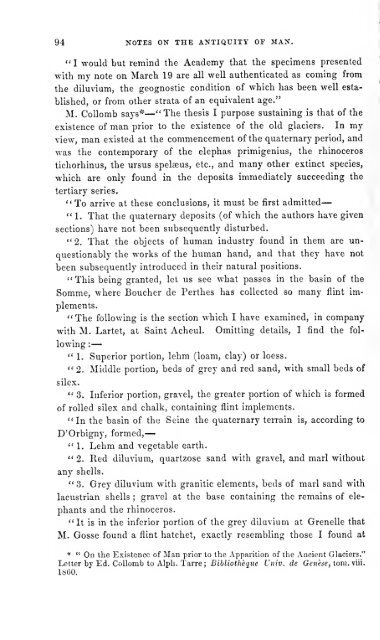The anthropological review - National Library of Scotland
The anthropological review - National Library of Scotland
The anthropological review - National Library of Scotland
Create successful ePaper yourself
Turn your PDF publications into a flip-book with our unique Google optimized e-Paper software.
94 NOTES ON THE ANTIQUITY OF MAN.<br />
" I would but remind the Academy that the specimens presented<br />
with my note on March 19 are all well authenticated as coming from<br />
the diluvium, the geognostic condition <strong>of</strong> which has been well esta-<br />
blished, or from other strata <strong>of</strong> an equivalent age."<br />
M. CoUomb says*— " <strong>The</strong> thesis I purpose sustaining is that <strong>of</strong> the<br />
existence <strong>of</strong> man prior to the existence <strong>of</strong> the old glaciers. In my<br />
view, man existed at the commencement <strong>of</strong> the quaternary period, and<br />
was the contemporary <strong>of</strong> the elephas primigenius, the rhinoceros<br />
tichorhinus, the ursus spelaeus, etc., and many other extinct species,<br />
which are only found in the deposits immediately succeeding the<br />
tertiary series.<br />
"To arrive at these conclusions, it must be first admitted<br />
" 1. That the quaternary deposits (<strong>of</strong> which the authors have given<br />
sections) have not been subsequently disturbed.<br />
"2. That the objects <strong>of</strong> human industry found in them are un-<br />
questionably the works <strong>of</strong> the human hand, and that they have not<br />
been subsequently introduced in their natural positions.<br />
"This being granted, let us see what passes in the basin <strong>of</strong> the<br />
Somme, where Boucher de Perthes has collected so many flint im-<br />
plements.<br />
"<strong>The</strong> follov.'ing is the section which I have examined, in company<br />
with M. Lartet, at Saint Acheul. Omitting details, I find the fol-<br />
lowing :<br />
—<br />
—<br />
" 1. Superior portion, lehm (loam, clay) or loess.<br />
" 2. Middle portion, beds <strong>of</strong> grey and red sand, with small beds <strong>of</strong><br />
silex.<br />
" 3. Inferior portion, gravel, the greater portion <strong>of</strong> which is formed<br />
<strong>of</strong> rolled silex and chalk, containing flint implements.<br />
"In the basin <strong>of</strong> the Seine the quaternary terrain is, according to<br />
D'Orbigny, formed,<br />
"1. Lehm and vegetable earth.<br />
" 2. Red diluvium, quartzose sand with gravel, and marl without<br />
any shells.<br />
" 3. Grey diluvium with granitic elements, beds <strong>of</strong> marl sand with<br />
lacustrian shells ; gravel at the base containing the remains <strong>of</strong> ele-<br />
phants and the rhinoceros.<br />
"It is in the inferior portion <strong>of</strong> the grey diluvium at Grenelle that<br />
M. Gosse found a flint hatchet, exactly resembling those I found at<br />
* " On the Existence <strong>of</strong> Man prior to the Apparition <strong>of</strong> the Ancient Glaciers."<br />
Letter by Ed. Collomb to Alph. Tarre ; Bibliotheque Univ. de Genese, torn. viii.<br />
1860.<br />
—

















